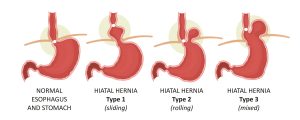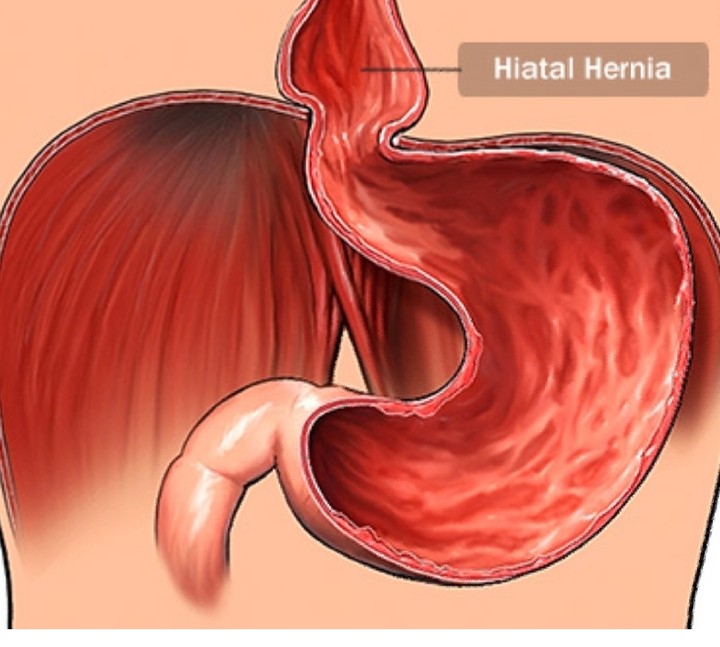What is a hiatal hernia?
A hiatal hernia occurs when the upper part of the stomach protrudes through an opening in the diaphragm. The diaphragm, a muscle separating the abdominal and chest cavities, can weaken over time, allowing organs to push through. Hiatal hernias are prevalent, especially as individuals age, and can develop gradually over the years.
Hiatal hernia types
There are two primary types: sliding and paraesophageal. Most cases (95%) are sliding hiatal hernias (Type 1), where the esophagus occasionally slides through the enlarged opening in the diaphragm. Paraesophageal hernias (Types 2-4) involve the stomach moving alongside the esophagus, forming a bulge. Type 4, though rare, may include herniation of multiple organs.
| Hiatal Hernia Type | Description |
|---|---|
| Type 1 (Sliding) | Esophagus slides through the enlarged hiatus occasionally. |
| Type 2 (Rolling) | Stomach moves up next to the esophagus, forming a bulge. |
| Type 3 (Mixed) | Combination of Types 1 and 2 symptoms. |
| Type 4 (Complex) | Rare, involving herniation of multiple organs. |

Symptoms and Causes
Hiatal hernia symptoms (in points)
- Heartburn: Burning sensation in the chest, especially after eating.
- Noncardiac chest pain: Recurring chest pain resembling angina.
- Indigestion: Feeling full soon after eating with abdominal pain.
- Burping and regurgitation: Food, gas, and acid rising back into the throat.
- Difficulty swallowing or lump in the throat.
- Sore throat and hoarseness due to acid irritation.
Hiatal hernia pain
Pain from a hiatal hernia, usually related to acid reflux, can manifest as chest or abdominal pain. Certain activities or positions, like bending over, coughing, or lifting heavy objects, may exacerbate pain. Severe pain might indicate worsening hernia conditions.
Causes of hiatal hernia
Hiatal hernias result from weak spots in the tissues separating body compartments. The esophageal hiatus, where the esophagus passes through the diaphragm, widens, allowing hernias to develop. Contributing factors include chronic coughing, constipation, obesity, frequent vomiting, intense exercise, heavy lifting, pregnancy, and childbirth.
How serious is a hiatal hernia?
Complications
While most hiatal hernias are not serious and may not cause symptoms, larger hernias can lead to chronic acid reflux. Complications include esophagitis (inflammation), esophageal stricture (narrowing), and Barrett’s esophagus (precancerous changes). Less commonly, hernias can cause gastrointestinal obstruction, gastritis, and ischemia.
Diagnosis and Tests
Diagnosing hiatal hernia
Healthcare providers use various tests to diagnose hiatal hernias, including:
- Chest X-ray: Reveals images of the chest cavity.
- Esophagram: Video X-ray of the esophagus during swallowing.
- Upper endoscopy: Uses a tiny camera to examine the esophagus and stomach.
- Esophageal manometry: Measures pressure in the esophageal muscles.

Management and Treatment
Do hiatal hernias go away?
Hiatal hernias do not spontaneously resolve; they often worsen over time. If asymptomatic, observation may be sufficient. For those with symptoms, mild cases can be managed with medications, while more severe cases may require surgical intervention.
Medical treatment
Treatment options include:
- Wait and watch: Monitor asymptomatic hernias as they may not require immediate treatment.
- Medications: Proton pump inhibitors (PPIs) reduce stomach acid, alleviating reflux-related symptoms.
- Surgery: Surgical repair, known as fundoplication, is considered for symptomatic cases not controlled by medications.
Surgery details
Hernia repair surgery involves pulling the stomach and lower esophagus back under the diaphragm, closing the hernia opening, and tightening the junction between the stomach and esophagus. This procedure, usually done laparoscopically, has a 90% success rate. Recovery may involve dietary restrictions, temporary symptoms, and weight loss. Want to Know Other Health Problems And Their Treatments
Outlook / Prognosis
Recovery from surgery
Recovery from hiatal hernia surgery typically requires a day or two in the hospital, followed by two to six weeks at home. During this period, a restricted diet progresses from clear liquids to soft foods and solids. Weight loss, around 10 to 15 pounds, is common.
Long-term effectiveness
Hiatal hernia surgery has a high success rate, allowing many to discontinue medications and enjoy life without acid reflux. Follow-up visits ensure the repaired hernia functions well. In some cases, hernias may recur after many years, but these can often be addressed with additional surgery.
Living With
At-home management
For those with occasional symptoms, managing hiatal hernias at home involves:
- Over-the-counter antacids for occasional acid flare-ups.
- Lifestyle changes: Maintain a healthy BMI, consume smaller and less fatty meals, eat dinner earlier, adjust sleeping positions, and quit smoking.
Understanding and managing hiatal hernias empower individuals to lead comfortable lives. Regular follow-ups and a balanced lifestyle contribute to long-term well-being.




